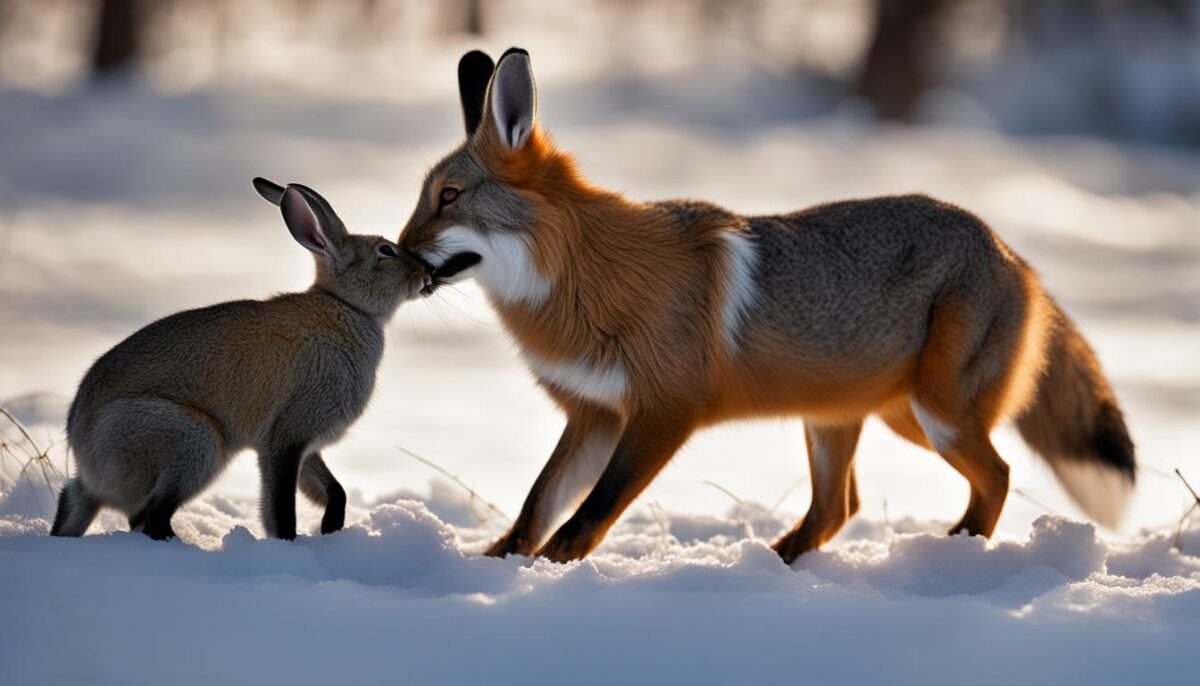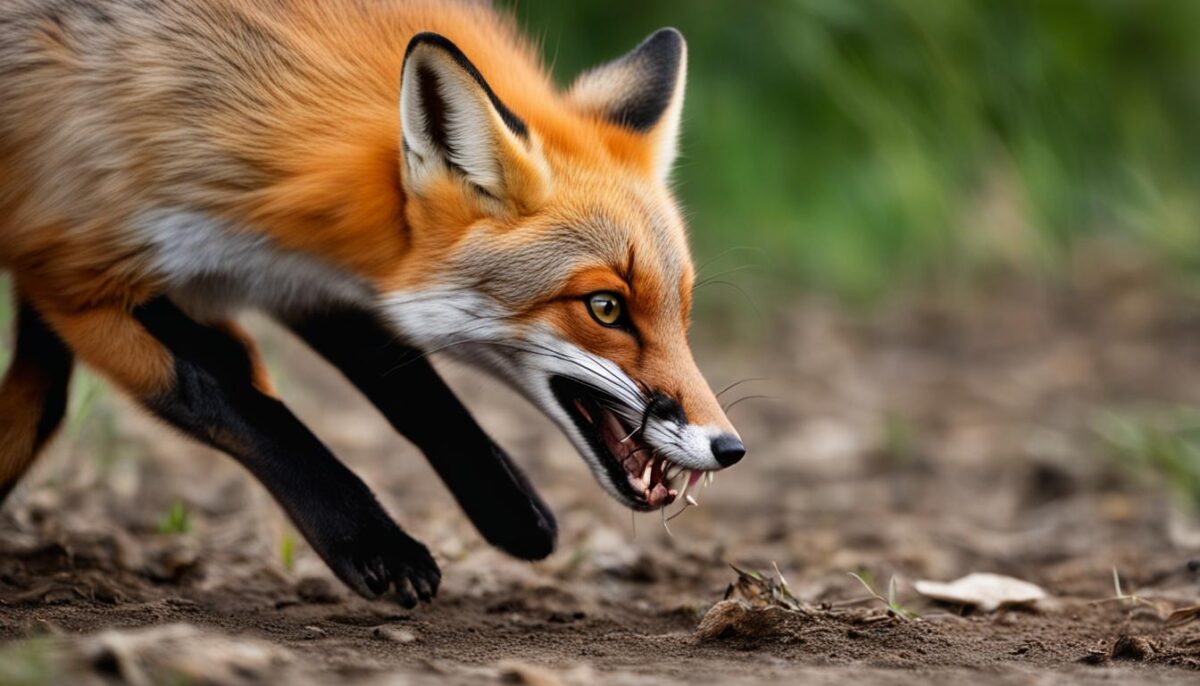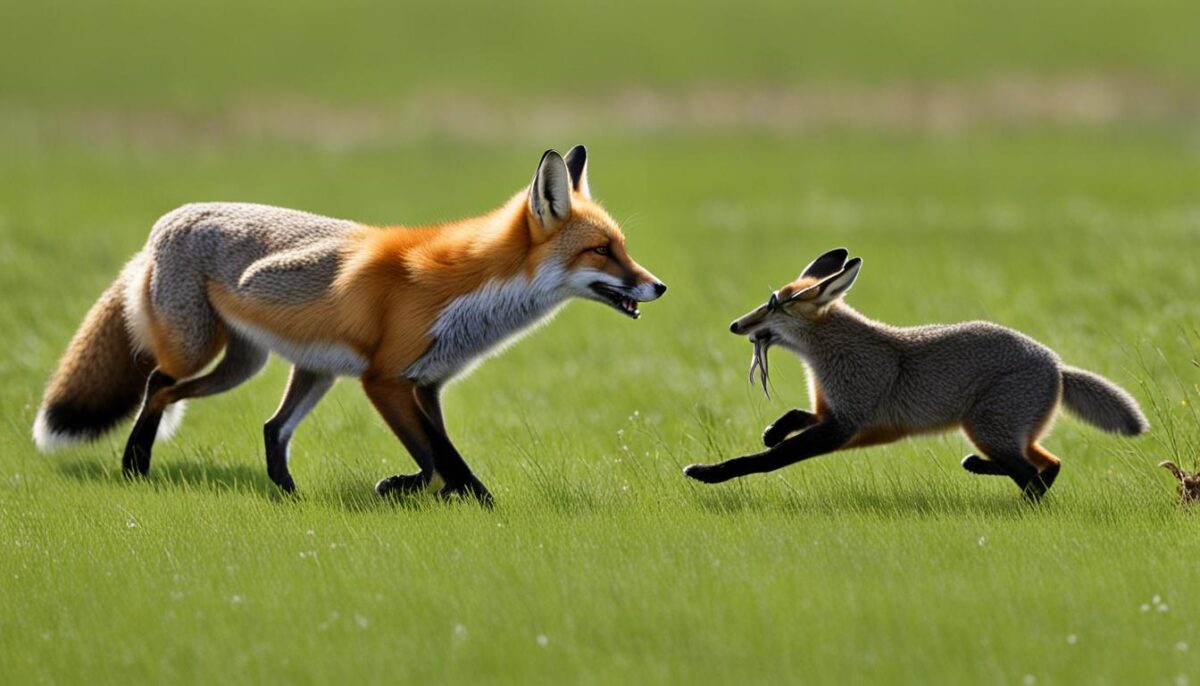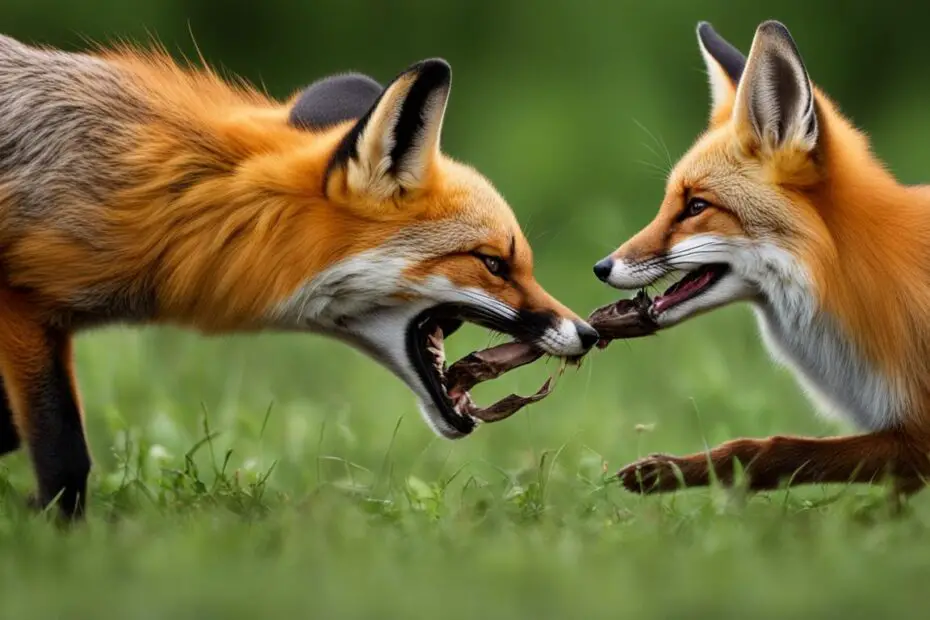Foxes are known to be cunning predators, but do they really bite the heads off rabbits? Let’s delve into the behavior of foxes and their hunting habits to find out the truth.
Key Takeaways:
- Foxes are predators that hunt and seize other animals for food.
- Predatory behavior varies based on factors such as prey vulnerability, adaptations, and the specific ecosystem.
- Understanding the dynamics of predator-prey relationships can shed light on foxes’ interaction with rabbits.
- Rabbits possess vulnerabilities that make them attractive targets for predators like foxes.
- Experimental approaches provide valuable insights into the hunting habits of foxes and their predation on rabbits.
Understanding Predator-Prey Relationships
Predators and prey are integral components of any ecosystem, shaping the delicate balance of nature. Foxes, as cunning predators, engage in a complex relationship with their potential prey, including rabbits. By exploring the dynamics of predator-prey relationships, we can gain valuable insights into the behavior of foxes and their hunting habits.
When it comes to foxes versus rabbits, it is important to understand that foxes are opportunistic hunters, adapting their tactics based on the circumstances. While they may occasionally go for the head, there is no conclusive evidence to suggest that foxes bite the heads off rabbits specifically. Their hunting strategy often involves targeting the neck or throat region to incapacitate their prey swiftly.
“Foxes employ a variety of hunting techniques, utilizing their exceptional speed, agility, and acute senses to stalk and ambush their prey. While they can deliver a fatal bite to the head, their aim is usually to disable their prey quickly by targeting vulnerable areas.”
It is important to recognize that the interaction between foxes and rabbits is influenced by multiple factors, such as the availability of alternative prey, the density of rabbit populations, and the specific habitat in which they coexist. Additionally, rabbits have evolved various adaptations, such as their ability to freeze or flee when detecting a predator, which further affects the outcomes of predator-prey interactions.
The Role of Ecosystem Factors
The behavior of both predators and prey is intricately linked to the characteristics and dynamics of their ecosystem. The availability of food sources, vegetation cover, and other environmental factors can significantly influence the hunting habits of foxes and the susceptibility of rabbits to predation. Understanding the interplay between these ecosystem factors is essential for comprehending the relationship between foxes and rabbits.
| Factor | Effect on Foxes | Effect on Rabbits |
|---|---|---|
| Food availability | Determines hunting success and abundance of foxes | Influences population size and vulnerability of rabbits |
| Vegetation cover | Provides hiding spots and increases hunting efficiency | Offers protection and reduces exposure to predators |
| Predator presence | Affects competition for prey and territorial behavior | Triggers anti-predator responses and alters foraging behavior |
By examining the intricate relationship between foxes and rabbits within the broader context of their ecosystem, we can gain a deeper understanding of the predatory behavior of foxes and the dynamics of rabbit predation. This knowledge is crucial for effective wildlife management and conservation efforts, ensuring the preservation of both predator and prey populations.
The Adaptations of Predators and Prey
Prey animals, such as rabbits, have developed various adaptations to protect themselves from becoming another animal’s dinner. These adaptations are the result of millions of years of evolution, enabling them to survive in a world filled with predators. One such adaptation is camouflage, where rabbits have fur that blends seamlessly with their surroundings, making it difficult for predators like foxes to spot them.
In addition to camouflage, rabbits have highly developed senses that allow them to detect predators even before they are spotted. Their large, alert eyes provide excellent vision, while their large ears can pick up the slightest sounds of approaching danger. This heightened sense of hearing and sight gives rabbits an advantage in evading predators.
Rabbits also employ warning signals and defensive behaviors to ward off potential predators. When they sense danger, they thump their feet on the ground, creating vibrations that act as an alarm to other rabbits in the area. This warning system helps alert the group and allows them to take evasive action. Furthermore, rabbits have the ability to run at high speeds and change direction quickly, making it challenging for predators like foxes to catch them.
Table: Adaptations of Prey Animals
| Adaptation | Description |
|---|---|
| Camouflage | Rabbits have fur that blends with their surroundings, making them difficult to detect. |
| Heightened Senses | Rabbits have large eyes and ears, allowing them to see and hear potential predators. |
| Warning Signals | Rabbits thump their feet on the ground to warn others of approaching danger. |
| Defensive Behaviors | Rabbits can run at high speeds and change direction quickly to evade predators. |
On the other hand, predators like foxes have also evolved their own set of adaptations to successfully hunt their prey. Foxes possess exceptional agility and speed, allowing them to chase down their quarry with precision. Their keen sense of smell enables them to track the scent of rabbits, even when they are hidden underground in burrows. Additionally, foxes have sharp teeth and claws that are specifically designed for capturing and subduing their prey.
Understanding the adaptations of both predators and prey provides valuable insights into the dynamics of their interactions. It demonstrates the constant evolutionary arms race between these species and showcases the intricate balance that exists within ecosystems. By studying these adaptations, scientists can gain a deeper understanding of the behavior and survival strategies of both foxes and rabbits.

“Camouflage, heightened senses, warning signals, and defensive behaviors are some of the ways prey animals protect themselves from predators.”
Exploring the Food Chain
The concept of the food chain is essential in understanding the dynamics of ecosystems and the interactions between different organisms. In the case of foxes and rabbit predation, the food chain provides valuable insights into the hunting habits of foxes and their role as predators.
In the food chain, foxes occupy the position of a higher-level predator, while rabbits are considered prey. This means that foxes rely on rabbits as a food source, and their hunting habits are influenced by the availability and behavior of rabbits in their environment.
An important aspect to consider is the interdependence of the food chain. As foxes hunt rabbits, they help regulate the rabbit population, preventing overpopulation that could negatively impact vegetation and other animal species. This balance is crucial for maintaining a healthy ecosystem.
| Food Chain Level | Organism | Role | |
|---|---|---|---|
| 1 | Plants (Producer) | Convert sunlight into energy through photosynthesis | |
| 2 | Herbivores (Primary Consumers) | Feed on plants for energy | |
| 3 | Rabbits | Prey for foxes | |
| 4 | Foxes (Secondary Consumers) | Predators of rabbits |
Understanding the food chain helps us put into perspective the role of foxes in the larger ecosystem and their impact on rabbit populations. While foxes may prey on rabbits, it is essential to consider their hunting habits within the context of maintaining balance and biodiversity in nature.
Analyzing Feeding Signs and Behaviors
When it comes to understanding the hunting habits of foxes and their predation on rabbits, analyzing feeding signs and behaviors can provide valuable insights. By observing how foxes interact with their prey and the remains they leave behind, we can gain a better understanding of their biting behavior and hunting techniques.
One common behavior exhibited by foxes is the consumption of larger bones while leaving behind smaller ones when feeding on carcasses, such as deer. This pattern can potentially shed light on how foxes interact with rabbits during the hunting process. By examining the remains left behind after a fox has preyed upon a rabbit, we can determine if the heads are indeed removed or if this is a misconception.
Additionally, studying the feeding signs and behaviors of foxes in different environments can provide valuable comparative data. Observing how foxes hunt and consume prey in various habitats can offer insights into their adaptive strategies and hunting techniques. For example, foxes in open grasslands may exhibit different feeding behaviors compared to those in forested areas, which can influence their interaction with rabbits as prey.
Table: Comparison of Feeding Signs and Behaviors of Foxes
| Feeding Signs | Behaviors |
|---|---|
| Bite marks on bones | Indicates the strength and size of prey targeted |
| Presence of fur or feathers | Suggests predation on mammals or birds |
| Scattered remains | Indicates feeding behavior and hunting style |
| Consumption of specific body parts | Reveals preferences and strategies for prey capture |
| Distinct marking or scenting | Used as a territorial behavior to communicate with other foxes |
By carefully analyzing the feeding signs and behaviors of foxes in relation to rabbit predation, we can gain valuable insights into their biting behavior and hunting habits. This knowledge can help dispel misconceptions and provide a more accurate understanding of the predator-prey dynamics between foxes and rabbits.

Vulnerability of Prey Animals
In order to understand the biting behavior of foxes and their predation on rabbits, it is important to consider the vulnerabilities of prey animals. Rabbits, like many other prey species, possess unique characteristics that make them more susceptible to predation by predators such as foxes.
One vulnerability of rabbits is their slow growth to sexual maturity. This slow development means that young rabbits are particularly vulnerable to predation as they are not yet able to effectively escape or defend themselves. Additionally, rabbits have relatively low rates of egg production, which limits their ability to quickly replenish their population in the face of predation pressure.
Furthermore, rabbits often rely on nests or burrows as a means of protection. However, these nests and burrows can be a double-edged sword, as they provide shelter but also create extended periods of vulnerability for rabbits. Predators like foxes may be able to locate and access these hiding places, increasing the risk of predation.
| Rabbit Vulnerabilities | Impact on Predation |
|---|---|
| Slow growth to sexual maturity | Increases vulnerability of young rabbits |
| Low rates of egg production | Limits ability to replenish population quickly |
| Reliance on nests and burrows | Creates extended periods of vulnerability |
The Impact on Foxes’ Predatory Behavior
These vulnerabilities of prey animals, including rabbits, can influence the predatory behavior of foxes. Foxes may target areas where young rabbits are more likely to be found, taking advantage of their vulnerability. They may also focus their hunting efforts on areas with a high concentration of rabbit nests or burrows. By understanding the vulnerabilities of prey animals and their impact on predation, we can better assess the likelihood of foxes biting the heads off rabbits.
Understanding the vulnerabilities of prey animals can help us understand the behavior of their predators.
It is important to note that while foxes are known to prey on rabbits, biting off the heads of rabbits specifically may not be a common behavior. Foxes typically seize their prey by the neck or throat, aiming to incapacitate it quickly. However, the notion of foxes biting the heads off rabbits may be more of a myth or exaggeration rather than a widespread behavior.

By considering the vulnerabilities of prey animals, we can gain a deeper understanding of the dynamic between foxes and rabbits. The predation of rabbits by foxes is influenced by various factors, including prey vulnerability, the hunting tactics of foxes, and the specific ecological context in which this interaction takes place.
Experimental Approaches to Studying Predator Effects
Understanding the hunting habits and predatory behavior of foxes in relation to rabbit predation requires comprehensive studies and experimental approaches. Researchers have employed various methods to gain valuable insights into the interactions between foxes and their prey. One such approach is the deletion of invasive predators from island food webs, which helps determine the impacts on island species and ecosystems.
An experimental study conducted by Researcher Name investigated the effects of fox predation on rabbit populations. The study involved setting up controlled environments where foxes and rabbits coexisted. By manipulating the presence of foxes and monitoring rabbit populations over time, the researchers were able to observe the direct influence of fox predation on rabbit numbers.
Key Findings from the Study:
- The presence of foxes significantly reduced the rabbit population.
- The frequency of fox attacks on rabbits increased during periods of scarcity when alternative prey was scarce.
- Foxes displayed a preference for preying on younger rabbits, which may be due to their vulnerability and relative ease of capture.
This experimental approach provided concrete evidence of the predatory behavior of foxes and their impact on rabbit populations. The results highlight the importance of considering factors such as prey abundance and vulnerability when studying predator-prey dynamics.
| Factor | Impact |
|---|---|
| Prey abundance | Higher prey abundance may reduce the likelihood of foxes resorting to extreme predatory behaviors such as biting off the heads of rabbits. |
| Prey vulnerability | Rabbits that display defensive behaviors or possess adaptations that make them more difficult to capture may be less likely to fall prey to foxes. |
| Alternative prey availability | When other prey options are scarce, foxes may increase their predation on rabbits, resulting in more intense hunting behaviors. |
In conclusion, experimental approaches offer valuable insights into the hunting habits and interactions between foxes and rabbits. These studies demonstrate the predatory behavior of foxes and shed light on the factors that influence their predation patterns. Through controlled experiments and observations, researchers continue to deepen our understanding of these predator-prey relationships and the dynamics of ecosystems.
Foxes and Prey Behavior: Insights into their Hunting Habits
As we have explored the behavior of foxes and their predatory habits, it is important to consider their interactions with different prey species. While we have primarily focused on the relationship between foxes and rabbits, it is crucial to broaden our perspective and understand the predator-prey dynamics in various ecosystems.
For instance, a global assessment of seabird declines has shed light on the impacts of introduced predators, including foxes, on seabird populations worldwide. These assessments give us a broader understanding of foxes’ hunting habits and their predatory behavior beyond just rabbits.
By analyzing these global assessments, we can gain valuable insights into the vulnerabilities of different prey animals and the strategies employed by predators like foxes. The complex interplay between predator and prey in diverse ecosystems helps us appreciate the adaptability and resourcefulness of both species.
Table: Summary of Global Seabird Declines
| Year | Region | Number of Seabird Species Affected | Predators Involved |
|---|---|---|---|
| 2002 | New Zealand | 17 | Foxes, cats, rats |
| 2008 | North Atlantic | 12 | Foxes, mink |
| 2014 | South Atlantic | 9 | Foxes, rats |
| 2020 | Arctic | 6 | Foxes, polar bears |
While our focus remains on the interactions between foxes and rabbits, these global assessments provide valuable context for understanding the broader implications of predator-prey relationships in different ecosystems. It is through these assessments that we can gain a deeper appreciation for the complexities of nature’s balance and the hunting habits of foxes.

Conclusion
The behavior of foxes in relation to rabbits can be complex and multifaceted. While foxes are known to be predators and can prey on rabbits, there is no conclusive evidence to suggest that they bite the heads off rabbits specifically. The hunting habits and predatory behavior of foxes vary based on various factors, including prey vulnerability, adaptations, and the specific ecosystem they inhabit.
Understanding predator-prey relationships and the adaptations of both predators and prey is crucial in unraveling the dynamics of foxes and rabbits. Prey animals, like rabbits, have developed camouflage, warning signals, and defensive behaviors to protect themselves. Predators, such as foxes, have their own set of adaptations enabling them to successfully hunt their prey.
By analyzing the feeding signs and behaviors of foxes, researchers can gain better insights into their hunting habits. These behavioral patterns, like selective consumption of larger bones, can provide clues about how foxes interact with rabbits when hunting. Experimental approaches and global assessments also contribute to our understanding of predator effects and the broader impacts of predation on different ecosystems worldwide.
FAQ
Do foxes really bite the heads off rabbits?
While foxes are known to be predators and can prey on rabbits, there is no conclusive evidence to suggest that they specifically bite the heads off rabbits.
What is the relationship between foxes and rabbits?
Foxes are predators, and rabbits are one of their potential prey. Understanding predator-prey relationships can shed light on their interactions.
What adaptations do prey animals, like rabbits, have against predators?
Prey animals have developed various adaptations to protect themselves, including camouflage, highly developed senses, warning signals, defensive weapons, and behaviors.
How does the food chain relate to foxes and rabbit predation?
Foxes occupy the position of predators in the food chain, while rabbits are considered prey. Analyzing the trophic levels in the food chain provides insights into foxes’ hunting habits and predation of rabbits.
What can we learn from analyzing the feeding signs and behaviors of foxes?
By studying how foxes feed on larger bones and leave smaller ones behind, we can gain insights into how they interact with rabbits when hunting.
Why are rabbits more vulnerable to predation?
Rabbits have vulnerabilities such as slow growth to sexual maturity, low rates of egg production, and extended periods of vulnerability in nests or burrows, making them attractive targets for predators like foxes.
How do experimental approaches help us understand predator effects?
Experimental methods, such as removing invasive predators from island food webs, provide valuable insights into the hunting habits and predation patterns of foxes.
What impacts do introduced predators have on seabird populations?
Seabird populations worldwide have been significantly affected by the predation of introduced predators, providing a broader understanding of the hunting habits and predatory behavior of foxes.
What can we conclude about foxes and their hunting habits?
While foxes are predators that hunt rabbits, there is no conclusive evidence to suggest that they specifically bite the heads off rabbits. Their hunting habits and predation behavior vary based on various factors and the specific ecosystem they inhabit.
Source Links
- https://mountainlion.org/2020/11/03/mountain-lion-kill-site-forensics-identifying-predation-scavenging-and-kleptoparasitism/
- https://royalsaskmuseum.ca/pub/Educate/Student Resources/Life Sciences/predator-and-prey-adaptations.pdf
- https://www.stat.auckland.ac.nz/~jrussell/files/papers/03-Mulder-03.pdf


